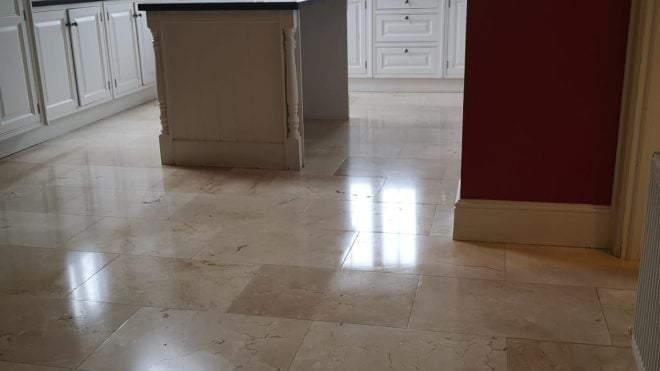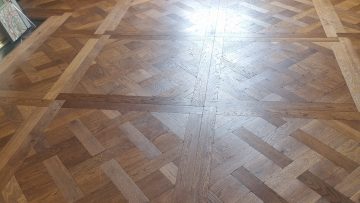While marble is a strong structure, its porous nature gives it a high tendency of absorbing stains. In fact, even water can end up leaving marks on the marble- especially if it has dissolved salts in it. The products used during cleaning and maintenance need to be specially formulated for working on marble. Neglecting the surface for a long time results in the applied treatments wearing down exposing the underlying structure to more damage. Areas with high levels of traffic, and those susceptible to heavy soiling need more attention. Scratches are also a cause for concern, and they can be anything from slight blemishes that can be fixed using compound polishing, to deeper scratches that require intense diamond polishing. Chips, scratches, holes that call for epoxy filling- different restoration measures are required. There are even those cases with lippage, usually as a result of faulty installation that results in a ledge being created between neighbouring tiles, causing an uneven surface. These ledges need to be ground away through a levelling process. The deep stains and scratches can also be ground off the surface, then a honing process follows to smoothen it out. All this requires skill, experience and proper tools to get it done right, without putting your installation at risk. Leaving it to rookies or going the DIY route can result in costly damages. Dial up the expert marble restoration serves to take care of your installation.
We use a wide range of solutions
Our crew carry out the restoration process using products whose choice depends on the state that the current surface is in. For instance, for the marble surfaces that are particularly sensitive to acids, and those that shouldn’t be touched using aggressive products, formulations like the Faber A1 Grey come in. This one is specifically meant to work on delicate marble, where other agents would have otherwise caused an orange peel-effect on the surface. This unit reacts with the particular material, enhancing the shine. It does this while simultaneously increasing its dirt resistance and ability to withstand foot traffic. In this way, your delicate surfaces can be worked on without worries about danger to their structural integrity, or blemishes being formed. For those cases where quick and fast results are desired and there is the need to bypass those final steps of the mechanical polishing process, products like the Faber A1 Yellow are used. Here, the goal is maximizing on the polishing effect while cutting down on the amount of time and resources expended in the project.
To obtain a deep vitreous effect on the surface, increasing the clarity plus depth of shine, products like the Faber A2 Mix come in handy. It’s a wax-free formulation, that actually reacts with the marble surface, resulting in a longer lasting finish. The Faber A3 Yellow, on the other hand, is a wet polishing powder that enhances the non-slip attributes of the treated surface. There are even crystallization liquids that come into play when dealing with surfaces that have just lost some of the original gloss, and here the marble restoration is carried out with the “Spray Buffing” method. It provides a quick way for the worn out surface to be restored, without having to resort to a complete overhaul.
Mechanical polishing with top-of-the-range systems
We use quality and high-efficacy machinery for the polishing. Here, the units are of industrial grade, getting the tasks done in moments. From orbital sanders, to edgers and single head machines, we have them all, each designated to its particular section of the grinding and polishing in the marble restoration services. These in turn are fitted with quality abrasives, such as the discs and pads from the KGS brand. For instance, when wet polishing the marble surfaces with hand-held machines, the diamond discs like the resin bond KGS Speedline® MM or Speedline® CM can be used. They both have coloured QRS, and have grit levels going as high as 3000, allowing the surface to be highly polished. On the other side of the scale, when grinding down, the grit levels can be as low as the grey pad rated at 50 in the Speedline® MM line. The lowest grit level for the CM disc line is rated at 60. Hand pads can also be used too, like when working on sections of the marble installation that are irregular, and a machine wouldn’t effectively operate on them. KGS has units for this too, such as the Flexis® and Telum® handpads. These have been engineered with a foam block that is flexible, and onto which the diamond abrasives have been coated, giving them their functionality and superior performance when grinding the surfaces. Their nature makes them very versatile units, and can be used on multiple marble installations in residential and commercial establishments, for both wet and dry polishing.
When it comes to working with the expanding grubber drums, such as when polishing interior surfaces, products like the KGS Telum® Belt with its interlocking patterns can be used. Here, sizes range from ø15×30 all through to ø75×38, and our crew will utilise the most appropriate set up for your particular situation. The KGS Flexis BCT Belt is also used with the rubber drums, and features a high stock removal, with different grits from 60 up to 3000. For the renovation, when old treatments and finishes need to first be ground off the surface, or the cases where the floor is to be levelled, complete sets such as the KGS RENOVATOR™ System can be employed. These resin bond and non-woven diamond pads are tough, built for the intense abrasion task, and are fitted onto the single head machines that our crew comes with on site. The KGS Frankfurt system is a silver line that also comes in handy during the restoration, for the grinding at the initial stages to the fine polishing that comes at the tail end of the process. In fact, it incorporates the FLEXIS® FF pads, where the grits can get to as high as an 8000 rating.




What kind of prices do you charge per sq meter?
Can you polish a marble floor with a standard water based floor polish?
We have the right wet floor sign for your business
Carver Pulidek Deck Sealer